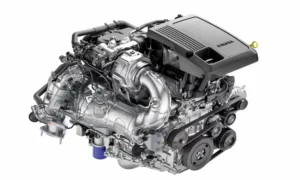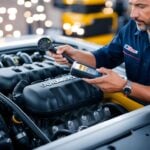When your GMC or Chevrolet Duramax diesel engine throws a P11DB code, it’s a clear sign something’s wrong with the NOx sensor. The good news is that understanding and fixing the P11DB code can save you from bigger issues down the road. Whether you’re a seasoned mechanic or a DIY enthusiast, stick around to find out how you can solve this problem and keep your diesel engine running smoothly.
Common Causes of the P11DB Code
The P11DB code can appear due to several reasons, including faulty parts and issues within the exhaust and electrical systems. Understanding these causes can help you pinpoint and resolve the problem efficiently.
Faulty NOx Sensor
A primary reason for the P11DB code is a defective nitrogen oxide (NOx) sensor. This sensor monitors levels of nitrogen oxide in your vehicle’s exhaust.
Over time, sensors can fail due to wear and tear or contamination from exhaust gases. When the NOx sensor is faulty, it may send incorrect data to the engine control module (ECM), leading to improper adjustments to the air-fuel mixture.
To fix this issue, replacing the faulty NOx sensor is often necessary. Make sure to use a high-quality replacement part to avoid future problems.
Issues with the SCR System
Another common cause is trouble within the Selective Catalytic Reduction (SCR) system. This system reduces NOx emissions by injecting a urea-based solution into the exhaust.
If the SCR system is not functioning correctly, the ECM may trigger the P11DB code. Possible issues include a clogged injection nozzle, malfunctioning SCR catalyst, or even a compromised urea tank.
To tackle SCR system problems, you may need to clean or replace components within the system, ensuring it reduces NOx emissions effectively.
Exhaust Gas Recirculation Problems
The Exhaust Gas Recirculation (EGR) system redirects a portion of exhaust gases back into the engine’s intake manifold, reducing NOx emissions. Problems in the EGR system can also trigger the P11DB code.
Common issues include blocked EGR valves or passages, affecting the flow of exhaust gases. When this happens, the system may fail to lower NOx levels adequately.
Inspecting and cleaning the EGR valve and related passages could resolve the problem. If cleaning doesn’t help, you may need to replace damaged components.
Wiring Harness and Electrical Connection Faults
Poor electrical connections or issues with the wiring harness can also lead to a P11DB code. Damaged or corroded wires can prevent the NOx sensor from sending accurate data to the ECM.
Often, you may find broken, bent, or pushed-out pins in the connectors, which affect the electrical connection. Corroded connectors can also impede proper sensor function.
Checking all electrical connections and the wiring harness for damage is critical. If needed, repair or replace faulty wiring and connectors to restore proper communication between the NOx sensor and the ECM.
Step-by-Step Fixing Guide
To fix the P11DB code in Duramax engines, you may need to replace the NOx sensor, repair the exhaust system, and handle electrical connection issues. Each step requires specific tools and attention to detail.
Replacing the NOx Sensor
First, locate the NOx sensor, which measures nitrogen oxide levels. It’s usually near the exhaust manifold.
Disconnect the wiring harness connected to the sensor. Use a wrench to unscrew the sensor from its mounting position.
Install the new sensor by screwing it in and reconnecting the wiring harness. Clear any fault codes from your engine control module to ensure the sensor is working correctly.
This process can take about an hour and requires basic tools like a wrench set and a diagnostic scanner.
Repairing the Exhaust System
Check the exhaust system for any leaks or damages that might affect sensor readings.
Inspect the exhaust pipes, catalytic converter, and muffler for cracks or holes. If you find any, seal smaller leaks with exhaust tape or putty. Larger issues may require replacing parts like the exhaust pipe or catalytic converter.
Ensure all connections are tight and secure, and keep the system free from rust and corrosion.
Repairing these issues helps the NOx sensor function properly and maintain engine performance.
Handling Electrical Connection Issues
Electrical issues often involve wiring harnesses and connectors. Start by visually inspecting the wiring connected to the NOx sensor.
Look for any signs of wear, corrosion, or loose connections. If you find damaged wires, use electrical tape or connectors to make repairs.
Ensure all connections are tight and free from dirt. Clean them with a contact cleaner if necessary.
Check for proper voltage using a multimeter, ensuring the sensor is receiving the correct electrical signals.
Addressing these issues ensures the sensor works reliably and prevents future code errors.
Preventive Measures and Maintenance
To keep your Duramax engine running smoothly and avoid the P11DB code, it’s crucial to include regular check-ups and proper maintenance of the Diesel Particulate Filter (DPF) in your routine. These steps help in identifying issues early and maintaining your vehicle’s performance.
Regular Check-Ups at the Dealership
Regular visits to the dealership can help spot problems before they become serious. Dealerships have specialized tools and trained technicians who understand the intricacies of Duramax engines. They can detect issues like faults in the NOx sensor, which can trigger the P11DB code.
During these check-ups, technicians can also perform updates to the engine’s software, which helps in keeping the performance at its best. Scheduled maintenance from professionals can save you from unexpected engine light warnings and costly repairs.
Maintaining the Diesel Particulate Filter (DPF)
Maintaining the DPF is essential to prevent errors related to emissions. The DPF traps soot from your diesel engine, reducing pollutants. Over time, this filter can get clogged, affecting engine performance and possibly triggering codes like P11DB.
To keep the DPF in good shape, it’s a good idea to follow the manufacturer’s recommendations for regeneration cycles. Regularly driving at highway speeds helps facilitate this process. Occasional check-ups at the dealership can also ensure the DPF is functioning correctly, preventing expensive repairs and keeping engine light issues at bay.
Technical Details of the NOx Sensor
The NOx sensor plays a crucial role in monitoring and reducing nitrogen oxide (NOx) emissions in diesel engines. It consists of different parts that work together to measure and control NOx levels.
Understanding the Sensing and Pumping Cell
The NOx sensor has two main components: the sensing cell and the pumping cell. The sensing cell detects the presence of NOx molecules in the exhaust gas. This part of the sensor is sensitive to changes in NOx concentrations.
The pumping cell, on the other hand, controls the amount of gas entering the sensing cell. It regulates the flow by emitting an electric current known as the pump current. This current is necessary to maintain balance in the sensor and ensure accurate readings.
Both cells are essential for the sensor’s performance. The sensing cell identifies NOx levels, while the pumping cell maintains the right conditions for the sensor to function effectively. This combination helps the engine control module (ECM) manage emissions more efficiently.
NOx Sensor’s Role in Emissions Control
The NOx sensor has a vital role in keeping emissions within legal limits. Located upstream and downstream of the selective catalytic reduction (SCR) system, the sensor provides real-time data on NOx levels in the exhaust gas.
Upstream sensors measure NOx concentrations immediately after the combustion process. This helps monitor the initial NOx output from the engine. Downstream sensors are placed after the SCR system to check the effectiveness of NOx reduction.
By comparing readings from both sensors, the system can adjust fuel injection and other parameters to reduce NOx emissions. This process is crucial for meeting emission standards and ensuring better air quality. The NOx sensor’s continuous monitoring and feedback help maintain a cleaner, more efficient engine.















